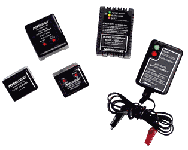| Power-Sonic SLA Battery Charger Characteristics | |
 |
| Characteristics: |
| "F" Series
Float chargers are designed to provide optimum life for batteries used in standby applications where charging is continuous. The chargers deliver a constant voltage of 2.25 to 2.30 volts per cell which allows the battery to seek its own current level and maintain itself in a fully charged condition. This series is best suited for burglar and fire alarm equipment, emergency lighting, memory protection or UPS systems where the battery serves as back-up power to th AC source. |
| "A" Series
Automatic dual rate chargers sense battery requirements and automatically switch from the fast charge to float mode, or vise versa. LED's provide visual indication of the charging mode. Automatic chargers combine the advantages of float and cycle chargers; recharge time is short yet batteries are safe from being overcharged. This charger is safe for cyclic applications where recharge time is critical and the battery may be left on charge indefinitely. As a result charging is fool proof. |
| Notes: Recharge time depends on the depth of the preceding discharge and the output current of the charger. To determine the approximate recharge time of a fully discharged battery, divide the batteries capacity stated in amp. hrs. by the rated output current of the charger (amps) and multiply the resulting number of hours by a factor of 1.75 to compensate for the declining output current during the charge cycle. If the amount of amp. hrs. discharged from the battery is known, use it instead of the batteries capacity to make the calculation. When charging batteries in series When charging batteries in
parallel |
